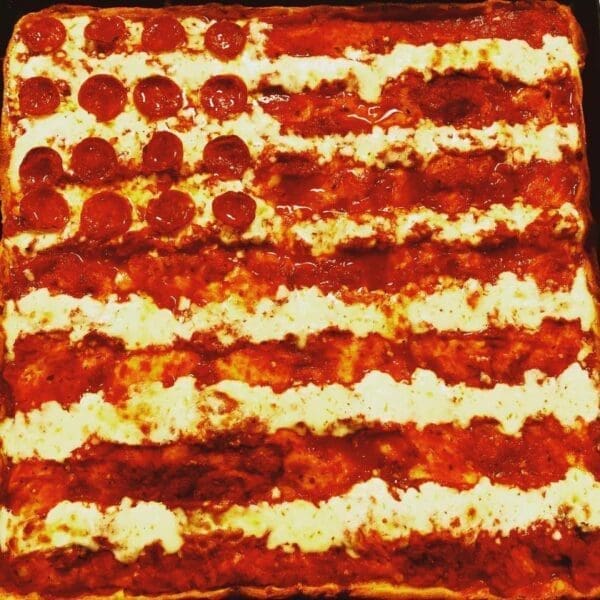The proliferation of Subway, McDonald’s and other chains has obscured many of Appalachia and the Rust Belt’s rich culinary traditions. For example, the strip of West Virginia, Ohio and Pennsylvania between Moundsville, WV, subject of our PBS film Moundsville, and Pittsburgh, where I live, is packed with quirky delis, delicious pizzerias and cozy locally-owned restaurants.
On Saturday, my friend Hal B. Klein, food writer for Pittsburgh Magazine, and I rolled south on an Ohio River culinary car trip. Taking Covid-19 precautions, we first hit Hanover Fuel Stop in Martin’s Ferry, OH. As lauded recently by Steve Novotney in Lede News, Hanover is a gas station, which happens to have a deli the size of a grocery store. As Novotney describes, owner John Ayers is a “foodie” who eschewed putting in a Subway because he wanted the real deal.
Hanover is worth the hour-ish drive from Pittsburgh. The sandwiches (roast beef and Italian for me, Italian and tuna for Hal) were perfectly composed, lightly toasted, and not greasy. And they’re huge, as suggested by their name– “hoggie” instead of hoagie.
A lot of gas stations used to have delis like this, Hal explained, before they almost all got crushed by chains, because that’s cheaper, and because travelers crave familiarity. But the tradition survives in places like Hanover, and it’s part of our national character. “Road food is a more American concept than street food,” Hal said.
Hanover is soon to expand its menu to include pizza and a wide selection of chicken wings. “Ayers and his staff have painstakingly created in the kitchen through trial and error what they feel is an incredibly tasty thin crust round pizza,” wrote Novotney.

It’s a Hoggie
Speaking of pizza, a lot of American businesses brand themselves the Original X, but our next stop, DiCarlo’s pizzeria in Steubenville, OH, really was one of the first pizza restaurants in the country that was not in the New York area. Its pizza has a very firm and crunchy crust, and is sprinkled with uncooked cheese. Delicious, yes. When this joint opened in 1945, pizza – or “poor man’s cheese cake” – was so unknown newspapers had to say what it was.
The story of our region’s pizza begins in Steubenville in 1945 when a first-generation American named Primo DiCarlo opened his eponymous storefront on the city’s main street. DiCarlo had just returned from serving in Italy, and he had a vision.“They would eat [a homestyle version of pizza] at home. When he was over in Europe, he saw they were actually selling it. When he got back, he thought it would be a great thing to try here. There was a big Italian community in Steubenville,” says his niece Toni DiCarlo. Her father, Galdo, joined his older brother in the venture.They had the wherewithal to do it, too — their father, Michael, an immigrant from Sora, Italy, opened the first Italian bakery in the region in 1896.The idea of selling that pizza was so new that when the DiCarlo brothers opened a second location in Wheeling, a 1949 News-Register article noted, “The brothers specialize in an Italian delicacy called Pizza, which has been called ‘the poor man’s cheese cake.’” Because hardly anyone knew what pizza was, the story goes on to describe it as “an Italian bread dough base garnished with a sauce of tomatoes, parsley and green peppers that’s seasoned with oregano, served with anchovies, cheese, pepperoni or mushrooms.”
Novotney concurs that chains have wiped out a lot of places like DiCarlo’s and Hanover but emphasizes how much is still left. “We are lucky here in the Upper Ohio Valley to have so many signature foods in this area,” he said, “and it’s a lot of fun for us when native return and have to get the Coleman’s Fish sandwich, a few slices of DiCarlo’s, or the garlic wings at Drover’s.” (And let’s not forget Bob’s Lunch and Acapulco in Moundsville.)

Your Money
For those not in the know (and I wasn’t before reporting this story), Coleman’s Fish Market is a Wheeling institution with a legendary fish sandwich, and Drover’s Inn & Tavern was built in 1848. According to the latter’s website, in the early 1850s Mr. Fowler, the original owner, “opened the Inn to travelers and drovers, moving their stock across the toll pike.” That, as they say, is tradition.
I’ll be visiting those places soon. The best way to make sure that great food places survive in America, especially as we crawl out of the pandemic, is to give them your money instead of McDonald’s or Subway.
And then stuff your face with deliciousness.


